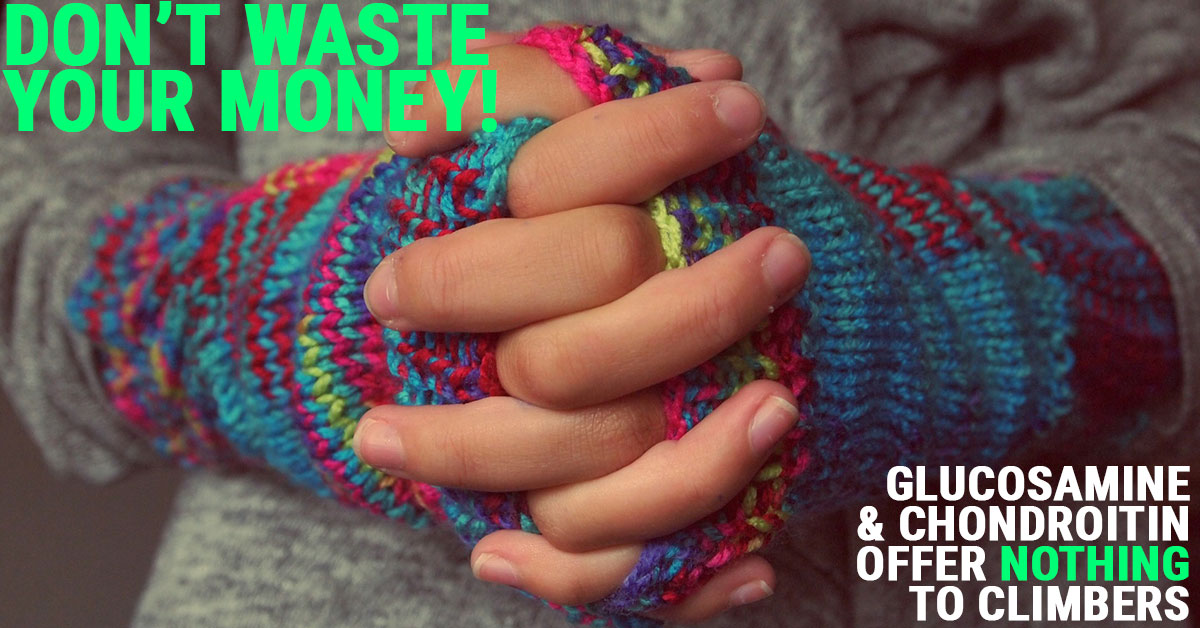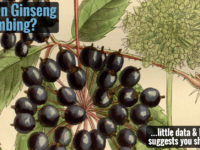Last week I published the official supplement guide for glucosamine and chondroitin, but I also wanted to write a second, more reader-friendly executive summary (and alternate analysis) for these guides so you don’t have to go through the entire 2,000 word (or longer) document to get why I made such-and-such a recommendation. So this week, I’m going to summarize the official guide and answer the critical question of why glucosamine and chondroitin don’t work for climbers.
Key Points
- Glucosamine and chondroitin are only effective at treating osteoarthritis.
- Glucosamine and chondroitin may be able to minorly slow cartilage degeneration, but cannot prevent it from happening in the first place.
- Climbing does not cause cartilage breakdown, and climbers are not at higher risk of osteoarthritis.
- Glucosamine and chondroitin do not affect any other type of connective tissue besides cartilage.
Point #1: Glucosamine and chondroitin are only effective at treating osteoarthritis
Nearly all research done on either glucosamine or chondroitin has been in relation to one disease: osteoarthritis. Osteoarthritis is a degenerative disease in which the cartilage between the joints is slowly worn away. The risk of osteoarthritis increases greatly with age, and often affects the finger joints, particularly the distal interphalangeal joint (the first joint down from the tip of a finger). Despite being common in the fingers, it is usually asymptomatic in those joints as well.
Point #2: Glucosamine and chondroitin may be able to minorly slow cartilage degeneration, but cannot prevent it from happening in the first place.
The research is equivocal when it comes to how effectively glucosamine and chondroitin can reduce the loss of cartilage—and all the research is on the major joints that have lots of cartilage, not the fingers that have comparatively little—but it’s probable that they will reduce cartilage loss to at least a minor extent. Whether this minor reduction is clinically meaningful and not just apparent from x-rays is a critical question, and most well-performed research indicates that it is not likely to have a strong clinical effect. In other words, glucosamine and chondroitin “work”, but they don’t really work.
There is little research on whether glucosamine or chondroitin are “chondroprotective”, or capable of protecting the cartilage, but what we do have suggests it is not. This shouldn’t be surprising since cartilage is normally very robust and not in need of protection; it’s only an atypical condition like osteoarthritis that can cause residual breakdown. Since developing osteoarthritis is unrelated to glucosamine or chondroitin themselves, they cannot prevent osteoarthritis—only slow its progression once it exists (and possibly not even then).
Point #3: Climbing does not cause cartilage breakdown, and climbers are not at higher risk for osteoarthritis.
Despite potentially being tough on the fingers, the act of climbing does not cause cartilage breakdown itself, and climbers do not suffer from osteoarthritis at a higher rate than the general public. Even the research that has shown climbers to have more signs of osteoarthritis has also shown that those same climbers had no joint space narrowing—essentially, they had the osteological (bone-related) signs of osteoarthritis, but not the chondrological (cartilage-related) signs.
Even though glucosamine and chondroitin are potentially effective at treating osteoarthritis, they can only treat the cartilage degeneration and pain—not the bone itself. Since climbers only display osteological signs and rarely report pain (associated with those changes), glucosamine and chondroitin have nothing to offer.
Point #4: Glucosamine and chondroitin do not affect any other type of connective tissue besides cartilage.
We don’t have a lot of human research to verify this—just one study so far in which athletes recovering from an injured ACL took either glucosamine or a placebo. The results were negative; both groups recovered equally. We really don’t need to exhaustively research this particular hypothesis to dismantle it, though, because it’s scientifically unlikely that glucosamine or chondroitin would affect a tissue other than cartilage, especially considering its already dismal success in that tissue. Here’s why:
Cartilage is approximately 50% type II collagen (by dry weight), 40% proteoglycans (proteins with carbohydrate sidechains), and 10% chondrocytes (cartilage cells). The predominant proteoglycan found in cartilage is aggrecan, which is largely responsible for the cushioning ability of cartilage; aggrecan makes up around 63% of all the proteoglycans in cartilage, or 25% of the total dry weight. Aggrecan is 93% carbohydrate by weight, and 72.5% of those carbohydrates (technically glycosaminoglycans) are chondroitin sulfate, meaning that almost 17% of the dry weight of cartilage is chondroitin sulfate.
Glucosamine also has a major role to play in the cartilage: around 0.05-0.25% of the wet weight of cartilage (or about 0.15-1% of the dry weight, age-dependant) is the glycosaminoglycan hyaluronan, which is approximately 50% glucosamine by weight. Hyaluronan forms a sort of gel that helps aggrecan molecules bind together and form the extracellular matrix, ensuring good compressibility; thus, both chondroitin and glucosamine play important roles in cartilage health.
By contrast, the proteoglycan content of tendons is low—only around 0.5% of the overall dry weight, most of that concentrated at the ends—and 88% of those proteoglycans are decorin (which doesn’t use chondroitin sulfate as its sidechain, but rather dermatan sulfate). The remaining 12% come from aggrecan (≈11%) and hyaluronan (≈1%). If we crunch those numbers, we can see that tendons are approximately 0.04% chondroitin sulfate and 0.0025% glucosamine—barely any! Just to make it more clear, here are the results side-by-side in a table with the multiplicative difference stated as well:
| Cartilage | Tendon | Overall Difference | |
| Chondroitin Sulfate Content | ≈17% | ≈0.04% | 425x |
| Glucosamine Content | ≈0.15-1% | ≈0.0025% | 60-400x |
Basically, there is around 400 times more glucosamine and chondroitin in the cartilage as in the tendons and ligaments (ligaments have similar, but slightly different compositions as tendons), making it unlikely that supplementing with either would have any meaningful effect on connective tissues aside from cartilage.
The Main Takeaway
If you don’t remember anything else about glucosamine and chondroitin, remember that they don’t work for climbers. Climbers do not typically suffer from cartilage degeneration in the fingers unless they already have osteoarthritis. Even then, it’s not clear whether there will be significant joint space narrowing as a result or if glucosamine and chondroitin could do anything to affect it. All of the studies on these supplements used major joints with significantly greater amounts of cartilage, and still only saw minor benefits—how much less of a benefit will we see when it’s the fingers and relatively small amounts of cartilage we’re trying to save?
Furthermore, glucosamine and chondroitin have absolutely zero effect on the connective tissue climbers do care about—the tendons and ligaments. Not only do we have little research to make such a claim (with the research we do have being negative), we have even less reason to believe they would. Cartilage is, in large part, composed of chondroitin and glucosamine; tendons and ligaments are not. For this reason, we shouldn’t expect glucosamine or chondroitin to help.
Truly, I don’t see a use for this supplement outside of some extremely limited scenarios, and even then it would be a “try and see” approach of very limited duration (6 months max). The research does suggest it could help relieve the pain of osteoarthritis, but it’s still inconsistent, and climbers only rarely complain of finger pain that is directly related to osteoarthritic changes, so it’s unlikely to help.
If you’re osteoarthritic, and happen to climb, perhaps this supplement may be worth trying. But it’s not a climbing supplement, and it provides no benefits in relation to climbing itself. So don’t be confused by the labels claiming that glucosamine and chondroitin are good for “joint health” or “connective tissue”—those are blatantly vague statements designed to trick you into believing there is support for these supplements where there is not.















However, climbing every day, fingers and joints will pain!
Please introduce a good supplement or medicine for finger pain.
Would that I could! There aren’t any on the market at this moment, and honestly I don’t expect there ever to be. The most I expect is that we’ll get a better understanding of how the nutrients we already know about interact with connective tissue and can be optimized for its repair.